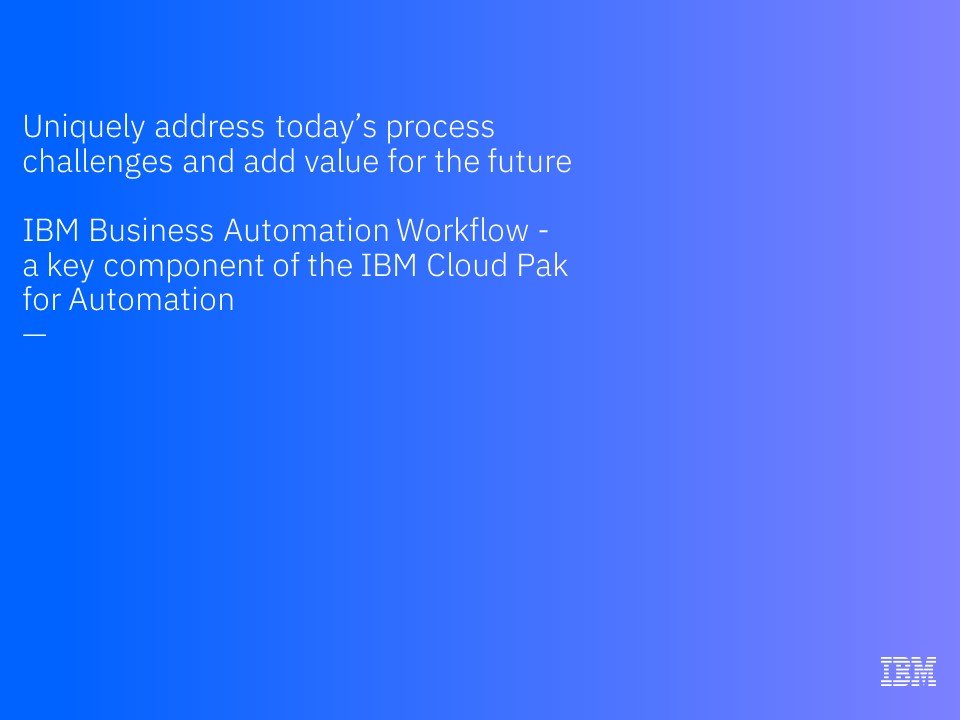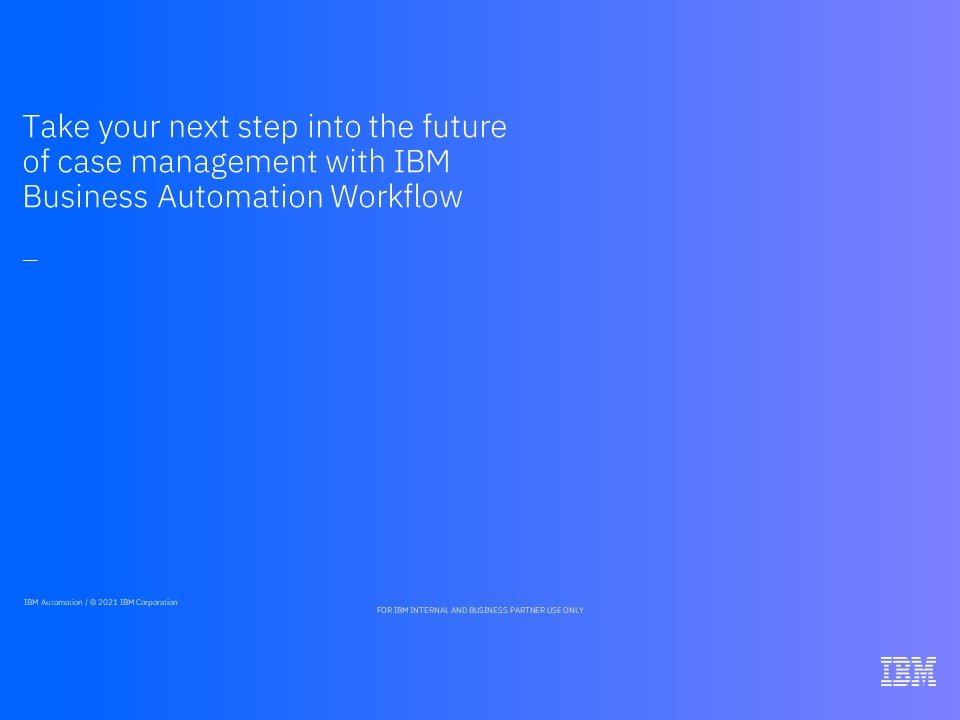
IBM Product Briefing
Reduce manual processes by up to 80% with IBM Business Automation Workflow.
IBM Business Automation Workflow enables you to design, build and run automation workflows on premise or in virtualised clouds. It combines business process management (formerly IBM BPM) and case management (formerly IBM Case Manager) capabilities in one workflow solution, uniting information, processes, and users to provide a 360-degree view of work. Business Automation Workflow also uses advanced analytics, business rules, and collaboration to drive more successful, optimised business outcomes.
- Seamlessly blend structured processes and unstructured case management into a single workflow to ensure smooth operations.
- Do more with less by deploying “hands off” processing, while expertly managing cases and exceptions.
- Enable business professionals to participate directly in designing business solutions, rather than forcing them to hand requirements over to IT.
- Deliver consistent, transparent experiences with standardised workflows that can be reused across the organisation.
Product names relevant to this briefing include IBM Integration, IBM Business Process Manager (BPM), WebSphere Process Server (WPS), IBM WebSphere, Enterprise Automation, Enterprise Integration, IBM Business Automation Workflow, IBM Digital Business Automation (DBA), IBM Case Management, Responsiv Unity Process Module and Responsiv Unity Case Extender.
Responsiv and IBM Business Automation Workflow (BAW)
Responsiv can provide the software, full cycle project support, and licence optimisation. We offer fixed price consulting for case management and process management projects.
Business Drivers
Staff carrying out repetitive tasks, typically results in inconsistent delivery and a significant cost for limited business benefit. Complex business processes are often not fully understood by the staff that implement them and new staff require a significant amount of training and supervision before they become proficient. These manual processes are difficult to monitor and optimise as data is not available on how they are performing.
Business Automation Workflow (BAW) allows you to automate these types of process in a phased approach to solving parts of the problem and carrying on with manual process in other places initially. This brings immediate business benefit from the partial automation and also the ability to monitor and optimise the process.
BAW delivers a powerful process management platform. Processes have a clear set of activities and well-defined outcomes. They can be designed and built to include human tasks, calls to internal and to external systems, or calculations, and measured using this software. Use Case management for sequences of activity that have a general direction but can take many different pathways are better implemented as cases. In this situation a caseworker performs activity from a restricted list against the “case”, which is then allowed to progress through different states to completion.
Key Capabilities
- The ability to switch to “human interaction” and back to automation at any point allows an end-to-end process to be implemented in a series of step where only some sections are initially automated, and manual checks can be performed if needed. This allows us to target the “pain points” first and get some early return on investment. Manual checks can be removed or reduced as confidence grows in the automation to the point where it is close to a fully automated process.
- The ability to switch between “Case Management” and “Business Process” in the same workflow allows us to create processes that manage unstructured data within a structured process.
- Detailed monitoring and progress reporting with built in escalation processing ensures the business has a clear view of what is happening and good measurement of any “Service Level Agreements” SLAs that are in place.
Use Cases
Government organisation providing public services, is moving call centre complaints to an online process. The complaints get routed to the correct “customer services team” with the relevant data attached. In some cases, the complaint can be automatically actioned without human interaction.
Retail returns process where customers are ordering several sizes of the same item and returning them to local stores, resulting in “out of place stock” that needs to be redistributed.
Financial loans & mortgage application process from an online portal, where the customer needs to be contacted by the call centre, part way through the process in some cases.
Why would you be interested?
BAW offers the ability to automate Business Process, Case Management and Business Rules in one product. It is a highly scalable and performant solution.
If you are concerned about:
- Repeatability of a manual process that your staff are running.
- Data is being entered into multiple systems, sometimes incorrectly.
- Staff have to access multiple systems to get the data they require.
- Lack of an audit trail, or a view of where process interaction is currently.
- Cost of mistakes that are a result of a manual process.
- Cost of staffing a predominantly manual process, particularly where the workload is uneven.
- The need to meet and prove adherence to regulatory requirements.
- The time a given outcome is taking for a process.
Enterprise Architects
BAW is a well-established, proven technology, that works with open standards. The solution is scalable and can be may highly available.
Operations managers & Administrators
BAW is based on a WAS runtime and will run on Unix, Windows and is available as a Cloud installation.
Developers
BAW development is a combination of configuration and Java development on an integrated development environment.

Richard Whyte has been building enterprise IT solutions for over 20 years. He is known for creating innovative practical solutions that provide a strong foundation for future development, whilst solving immediate problems. Previously the European CTO and Principal Architect for IBM Systems Middleware at IBM, he has an MBA, a degree in Statistics and Computing, is a Chartered Engineer, a Chartered IT Professional, and Fellow of both the Institute of Technology and the British Computer Society.




